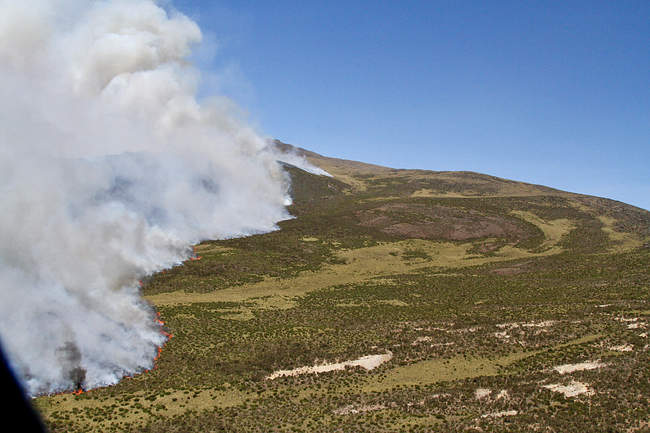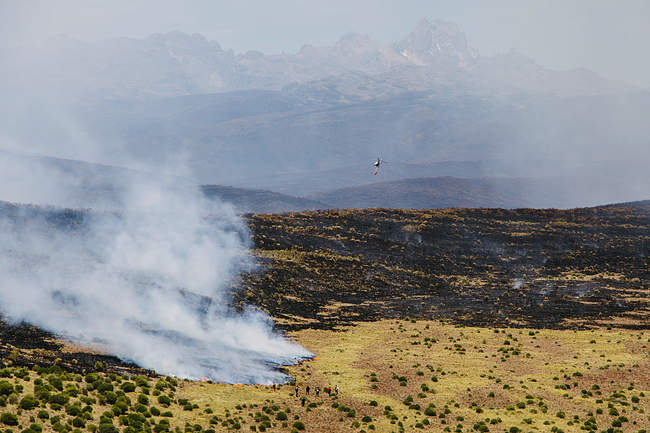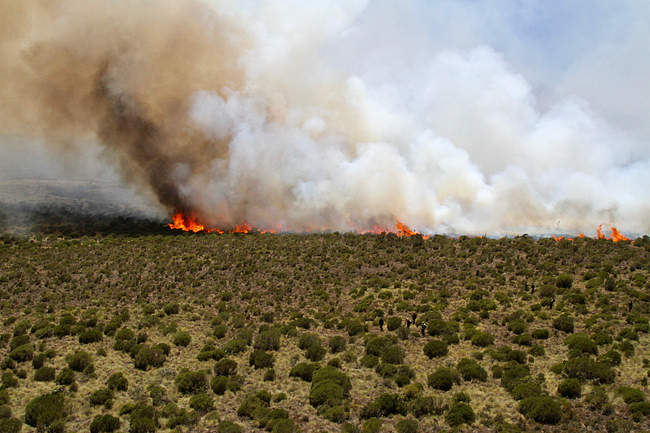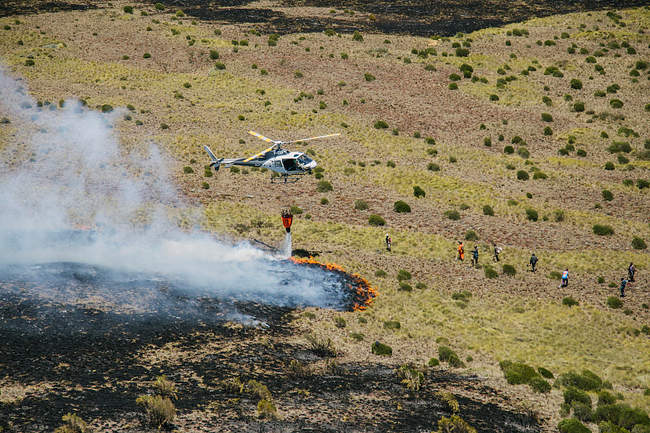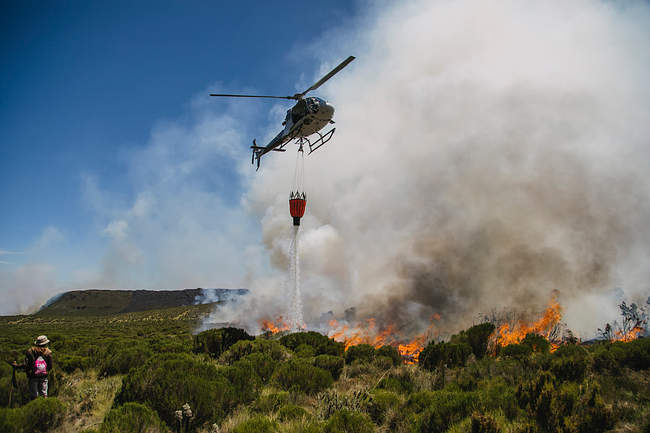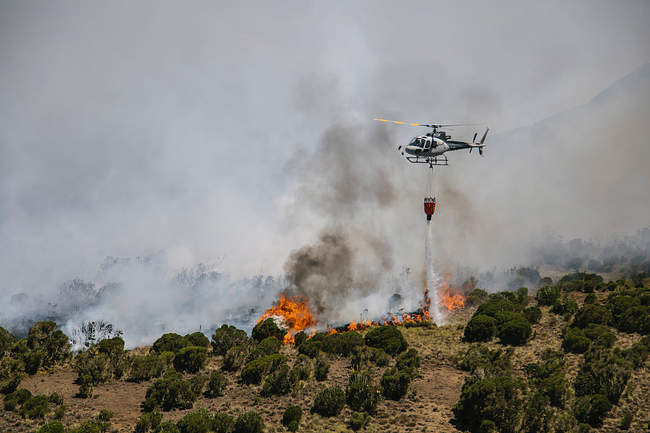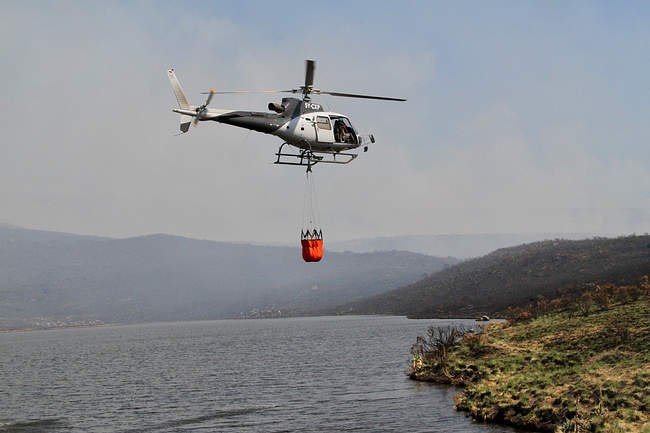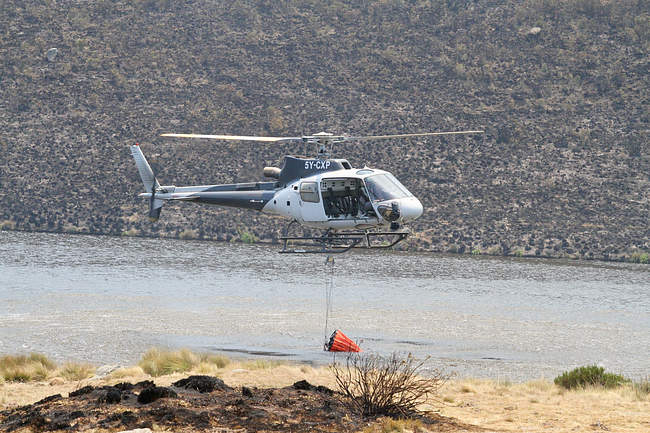The months of February and March in Kenya are very often considered ‘fire season’, with much of the country extremely dry; that coupled with the soaring hot temperatures and high winds typical of this time of year makes for a potentially very volatile time.
Sadly this year some devastating fires have swept through the country, mostly affecting Kenya’s forested regions and vital water towers. This month fires on Mount Kenya, the Aberdare Mountains and Arabuko Sokoke and Mau forests have swept through causing massive destruction.
The Trust was able to assist with the Mount Kenya fire when called upon in the early days of the fire when late on the 25th of February SWT was alerted by The Kenya Forest Service and Mount Kenya Trust about the crisis and asked to assist with aerial firefighting on the two big fires burning and now out of control on the mountain, which had first started on Saturday the 23rd. We agreed that the SWT helicopter 5Y-CXP would leave Tsavo first thing the following morning and fly up to Mount Kenya to report to the Nanyuki airstrip for a briefing. The helicopter was rigged up that night for Bambi Bucket operations (Firefighting bucket) and all the necessary gear was tested and packed on board.
Day 1 26/02
The following morning Alex Chikana, the heli technician and pilot Andy Payne landed in Nanyuki and were briefed by Christian Lamprechts from Rhino Ark, together with KWS, MKT and Tropic Air about the state of the fires. The northern fire line was approximately 6km long and burning across grass and heather of the moorland, whilst the bigger southern fire line was raging through forest and bamboo. It was decided that the SWT helicopter and ground crew of beaters would be more effective in tackling the northern fire line, by attacking its eastern edge near the Billiards table hill. Weather conditions on the mountain were not ideal for firefighting with clear skies but warm and gusting winds.
After arranging for drums of fuel to be transported to Kisima farm on the northern side of the mountain, the SWT team proceeded up to Lake Ellis for their own assessment of the conditions and fire. Whilst two Tropic Air helicopters were moving ground crew, equipment and rations onto the fire line, Andy tested the bucket and its weight capacity calculating the helicopters performance at an altitude of 11,000 plus feet. Even with low quantities of fuel on board he could safely manage up to 540 liters per drop, whilst pulling maximum power. Safety was foremost in mind whilst bucketing at that altitude on a gusty day.
It was not possible to knock out the eastern edge of the fire with the bucket due to difficult terrain and strong winds, so they focused on the area around Billiard table instead. Once the ground teams understood the role of the water bombing and started to work as a team-which is vital for water bombing to be successful on a big fire- good progress was made in putting out a section of fire. The grass fire was easier to control but when it got into patches of heather, the flames raged meters high and the fire was extremely difficult to contain. Throughout the morning and early afternoon the air and ground teams steadily worked hard at putting out a line of fire working from east to west, as it burnt northwards against the gusting prevailing wind.
A typical water bombing cycle started with filling the bucket in Lake Ellis and then slowly flying the heavy helicopter some 2 minutes to the fire. Lining up the helicopter with the fire line a load of 400-550 liters would be run along a 10-30 meter section from about 30-40 feet high, so that the beaters could get into this dowsed area and put out that section of fire. Then a quick turnaround to the lake through the dense smoke was made to collect another load.
At around 2pm the wind shifted drastically with dire consequences, the fire picked up and spread back into the area which we had cleared. This of course is incredibly demoralizing to see the hard work undone in a relatively short space of time. By 3:30pm the ground teams comprising of approximately 50 men were exhausted and water bombing with just one helicopter was no longer effective without the beaters.
Gear was packed up on the blackened shores of Lake Ellis and the heli returned to Nanyuki airstrip for a debrief with The Kenya Wildlife Service.
Day 2 27/02
Started with a briefing after The Kenya Wildlife Service had completed their early morning aerial recce of the two fires, it was noted that the northern fire line had been broken in several places as a result of yesterday’s efforts. SWT were again tasked with attacking the eastern edge of the northern fire, ground crews were already in place at the Billiard table and were awaiting heli support to be moved on the fire. Weather conditions were the same as yesterday on the mountain, clear skies, warm and strong dry winds which would favor the fires and make for another challenging day.
Initially the Tropic Air and the SWT helicopters began ferrying ground crew and equipment to the area of the fire selected to fight. The beaters were mostly comprised of community members under KWS direction, and once they were in position, the water bombing began. Excellent progress was made throughout the morning steadily working west and putting out a kilometer of fire line, which was still burning northwards through grassland and heather against the wind.
The team lost count of how many loads were dropped each day but would have been in excess of 40, which roughly equates to 16,000-20,000 liters of water dropped daily. The helicopter was refueled from jerry cans every hour so that it was operating light enabling a maximum load of water to be carried each time.
At 1:30pm there was a repeat of yesterday’s wind shift and within a short space of time, the fire was burning back into the area that the teams had worked so hard to clear during the morning. The ground and helicopter crew’s fought on until mid-afternoon, beating the fire back in several places until the ground teams retreated for a well-deserved rest.
At this point Andy decided to use the remaining fuel to water bomb the cedar forest below the Billiard table, which was raging. The fire was so intense that it took several drops to make an impact on the edge of the forest fire, by which time the fuel was running low and it was time to pack up the gear and head back down to Nanyuki for a debrief with The Kenya Wildlife Service once more.
Fires of that magnitude would ideally be tackled by several aircraft water bombing and with many more ground teams beating the dowsed sections, however resources were limited and spread thin over the mountain.
Cases of human wildlife conflict in Tsavo along with report of a couple of elephants requiring emergency veterinary treatment needing the helicopter to effect, forced Andy and the SWT helicopter to return to Tsavo, but by this time additional aircrafts were being mobilized to come in and assist with the ongoing operations on the mountain. By now the fire had attracted the attention of many more stakeholders given the severity of the situation. Eventually it took a collective herculean effort involving numerous stakeholders to get things under control, with KWS, KFS and the Mount Kenya Trust steering proceedings. Later the Kenya Defense force was brought in to bolster numbers firefighting on the ground and the fires continued to burn and present challenges for another week before the weather changed and the rain finally fell on the mountain and things were brought under control.

